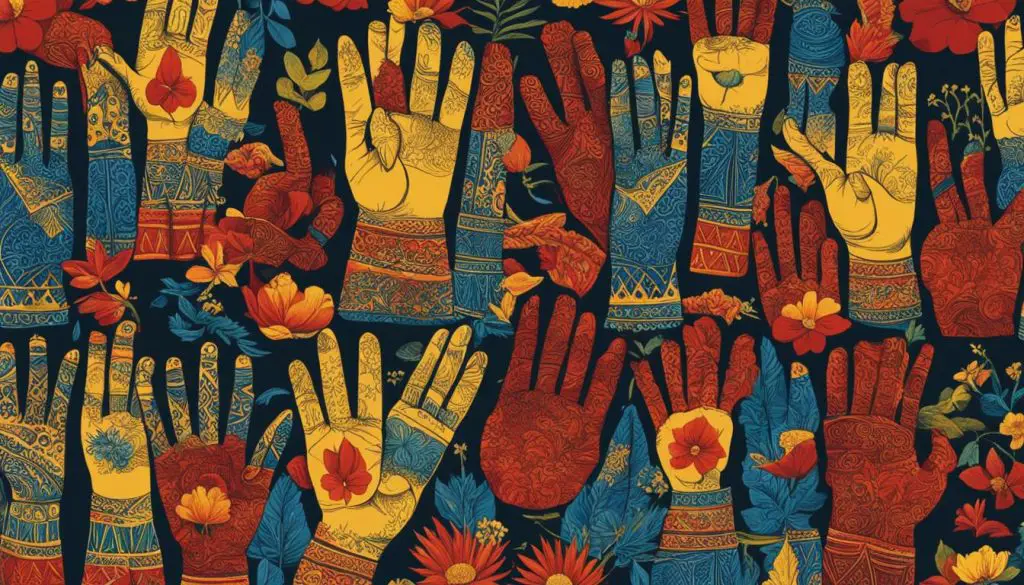Have you ever wondered where the tradition of crossing your fingers for good luck originated? The act of crossing fingers is a widely recognized gesture, often used to wish for luck or seek protection. But what are the origins of this fascinating practice? Let’s dive into the history of crossing fingers for good luck and uncover its mysterious beginnings.
Throughout history, crossing fingers has held different meanings and cultural significance in various regions. From its association with Christianity to its role in military conflicts, this gesture has a rich and evolving history. Let’s explore the fascinating origins and symbolism behind crossing fingers for good luck.
Contents
- 1 The Cultural Significance of Crossing Fingers for Good Luck
- 2 Related Gestures and Superstitions
- 3 Origin and Symbolism of Crossing Fingers for Good Luck
- 4 Origin of the V-Sign Gesture
- 5 The Historical Context of Crossing Fingers and V-Sign Gestures
- 6 Conclusion
- 7 FAQ
- 7.1 Where did the tradition of crossing your fingers for good luck come from?
- 7.2 What is the cultural significance of crossing fingers for good luck?
- 7.3 Are there other gestures and superstitions related to crossing fingers for good luck?
- 7.4 What is the origin of the crossed fingers gesture?
- 7.5 What is the origin of the V-sign gesture?
- 7.6 What is the historical context of crossing fingers and V-sign gestures?
- 8 Source Links
Key Takeaways:
- The act of crossing fingers for good luck has a long and evolving history.
- Its origins are unclear, but it may have been influenced by Christian symbolism and superstitions.
- While the gesture is well-known in the UK and parts of Scandinavia, it is less prevalent in mainland Europe.
- In some cultures, crossing fingers is a sign of lying, while in others, it is a gesture of wishing for luck.
- The crossed fingers gesture has connections to the Sign of the Cross in Christianity and its development as a secret communication among early Christians.
The Cultural Significance of Crossing Fingers for Good Luck
The act of crossing fingers for good luck holds a rich cultural significance in various regions around the world. While it is commonly associated with the Western notion of luck, its meaning and interpretation differ across different countries and cultures.
In some German-speaking and Slavic countries, crossing fingers is actually seen as a sign of lying, rather than a gesture for luck. On the other hand, wishing for luck is gestured by holding thumbs. Similarly, in South Africa, Afrikaans speakers have a related phrase called “duim vashou,” which means “holding thumbs tightly.”
In pre-Christian Western Europe, a related gesture involved crossing index fingers to form a cross, representing unity and used for making wishes. This ancient tradition showcases the deep-rooted significance attributed to the act of crossing fingers.
“The crossing of fingers is not universally understood and may be considered rude in certain cultures, such as Vietnam.”
However, it’s important to note that the cultural understanding of crossing fingers varies significantly. In certain cultures, such as Vietnam, the gesture is actually considered rude. Therefore, it is essential to be mindful of cultural differences when engaging in this tradition.
| Cultural Beliefs | Meaning |
|---|---|
| German-speaking and Slavic countries | Sign of lying |
| South Africa (Afrikaans speakers) | Wishing for luck |
| Pre-Christian Western Europe | Unity and making wishes |
| Vietnam | Considered rude |
Summary:
The act of crossing fingers for good luck has diverse cultural interpretations and meanings. While it is often associated with luck and protection, its significance varies across different regions. Understanding these cultural nuances is crucial to respecting and appreciating the traditions associated with crossing fingers for good luck.
Related Gestures and Superstitions
Alongside crossing fingers for good luck, there are other gestures and superstitions that are related to this age-old practice. While crossing fingers is generally seen as a sign of hoping for a positive outcome, it is important to note that cultural interpretations can vary.
In certain cultures, such as Vietnam, crossing fingers is actually considered rude. In German-speaking countries, Sweden, Latvia, and many Slavic countries, crossing fingers is associated with lying rather than wishing for luck. Instead, these cultures express their hopes and wishes by holding their thumbs tightly.
Superstitious beliefs have also linked the act of crossing fingers to the Sign of the Cross in Christianity. It is believed that crossing fingers represents the symbol of the cross and is used as a way to seek divine intervention or protection. However, it is important to note that these explanations are often unfounded and lack historical evidence.
| Country/Culture | Gesture |
|---|---|
| Vietnam | Crossing fingers is considered rude |
| German-speaking countries, Sweden, Latvia, Slavic countries | Crossing fingers signifies lying; luck is expressed by holding thumbs |
| Christianity | Superstitious belief linking crossed fingers to the Sign of the Cross |
Origin and Symbolism of Crossing Fingers for Good Luck
The crossed fingers gesture has a rich history and carries deep symbolism across different cultures. It is believed to have originated as a secret sign among early Christians during times of persecution. The gesture involved two people crossing their fingers to form an L shape and touching their thumbs together, creating a fish symbol representative of Christianity. Over time, this gesture became associated with luck and protection. During the Hundred Years’ War period in Europe, crossing fingers held particular significance as soldiers sought luck and divine intervention on the battlefield.
The symbolism of crossing fingers for good luck extends beyond its Christian origins. In some cultures, it represents unity and making wishes. For instance, in pre-Christian Western Europe, people crossed their index fingers to form a cross shape, symbolizing unity and hope for positive outcomes. This practice later evolved into crossing fingers specifically for good luck. Additionally, the gesture of crossing fingers has been linked to warding off evils and ill health, reflecting its protective symbolism.
To better understand the significance of crossing fingers for good luck, let’s take a closer look at the symbolism through a table:
| Symbolism | Culture |
|---|---|
| Unity and making wishes | Pre-Christian Western Europe |
| Luck and divine intervention | Early Christians during persecution |
| Protection against evils and ill health | Various cultures |
As seen in the table above, crossing fingers has diverse cultural meanings and interpretations. It continues to be a widely recognized gesture for good luck, although its significance may vary across different parts of the world.
Understanding the origin and symbolism of crossing fingers for good luck adds depth and meaning to this age-old tradition. Whether it stems from Christian beliefs or represents unity and protection, crossing fingers symbolizes the human desire for favorable outcomes and blessings. This gesture reminds us of our innate hope and belief in the power of luck and divine intervention.
Origin of the V-Sign Gesture
In the midst of the Hundred Years’ War, the origin of the V-sign gesture can be traced back to the English longbowmen who were known for their exceptional skills in combat. These formidable archers would raise their bow fingers, often targeted by the French, as a sign of defiance and taunt towards their adversaries. Over time, this gesture evolved into the V-sign, which became a symbol of offensive defiance in English culture.
During the extensive conflict between England and France from the 14th to 15th centuries, military strategies and equipment were constantly evolving. The longbow, used by English armies, played a significant role in their military advantage. As the longbowmen faced the French, they defiantly raised their bow fingers to show their prowess and demonstrate their intent to prevail on the battlefield. The V-sign gesture, originating from this practice, became deeply ingrained in English culture as a symbol of strength and offensive gesture.
The historical context in which the V-sign gesture emerged sheds light on its significance and enduring presence. It serves as a reminder of the bravery and defiance exhibited by English longbowmen during the tumultuous period of the Hundred Years’ War. Today, the V-sign remains an iconic gesture with cultural relevance, representing a spirit of resilience and triumph in the face of adversity.
The Historical Context of Crossing Fingers and V-Sign Gestures
The gestures of crossing fingers and the V-sign have a shared historical context rooted in the Hundred Years’ War between England and France during the 14th and 15th centuries. This period marked a time of significant military advancements, including the widespread use of the longbow by English archers. Crossing fingers became a cultural practice among soldiers, seeking luck and protection in the face of adversity.
The act of crossing fingers symbolized a plea for divine intervention and served as a form of communication among persecuted Christians. It was believed that crossing two fingers created the shape of a fish, a secret symbol representing Christianity. Soldiers would cross their fingers to silently communicate their faith and solidarity with one another during times of war.
“Crossing fingers became a powerful gesture that united soldiers in their shared beliefs and hopes for survival,” says historian Dr. Elizabeth Adams.
Parallel to crossing fingers, the V-sign gesture originated as a taunt towards the enemy. English archers, known for their skill with the longbow, would raise their bow fingers in defiance to provoke the French. This symbolic gesture eventually evolved into the V-sign, representing victory and defiance in English culture.
| Gesture | Historical Context |
|---|---|
| Crossing Fingers | Seeking luck and protection in the face of adversity during the Hundred Years’ War |
| V-Sign | Taunting the enemy during battle, symbolizing victory and defiance |
The historical context behind crossing fingers and the V-sign gestures provides insight into their cultural significance and enduring relevance in certain regions. These gestures serve as a reminder of the human desire for luck, protection, and unity, even in the midst of conflict.

Conclusion
In conclusion, the act of crossing fingers for good luck has a fascinating and evolving history. While the exact origins may remain unclear, this gesture holds cultural significance in various regions. It is associated with luck, protection, and even communication among persecuted Christians.
The related V-sign gesture, on the other hand, has its roots in the Hundred Years’ War, where it became a symbol of defiance and an offensive gesture in English culture. These gestures have endured over time, gaining cultural relevance and adding depth to the tradition of crossing fingers for good luck.
By understanding the historical and cultural context surrounding these gestures, we gain a deeper appreciation for their meaning and significance. So, the next time you find yourself crossing your fingers for good luck, remember the rich history behind this simple yet powerful gesture.
FAQ
Where did the tradition of crossing your fingers for good luck come from?
The origins of crossing fingers for good luck are unclear, but it may have been propagated through the supposition of its likeness to the Cross of Christ. In 16th-century England, fingers would be crossed in place of the Sign of the Cross to ward off evils and ill health. The gesture is well-known in the UK and parts of Scandinavia, but less so in mainland Europe.
What is the cultural significance of crossing fingers for good luck?
Crossing fingers for good luck holds cultural significance in certain regions. In some German-speaking and Slavic countries, crossing fingers is a sign of lying, while wishing for luck is gestured by holding thumbs. In South Africa, Afrikaans speakers have a related phrase called “duim vashou,” meaning “holding thumbs tightly.” However, crossing fingers for luck is not universally understood and may be considered rude in certain cultures, such as Vietnam.
Yes, in some German-speaking countries, Sweden, Latvia, and many Slavic countries, crossing fingers is a sign of lying, while wishing for luck is expressed by holding thumbs. In pre-Christian Western Europe, a related gesture involved crossing index fingers to form a cross, representing unity and used for making wishes. However, these explanations are often unfounded and lack historical evidence.
What is the origin of the crossed fingers gesture?
The most widely accepted origin theory is that it developed as a secret sign among early Christians to communicate with each other during times of persecution. It is believed that two people would cross their fingers to form an L shape and touch their thumbs together, creating a fish symbol, representing Christianity. Over time, the gesture became associated with luck and protection, particularly during the Hundred Years’ War period in Europe.
What is the origin of the V-sign gesture?
The V-sign gesture, similar to the American middle finger, has its origins in the Hundred Years’ War. English longbowmen used the longbow as their main weapon and would raise their bow fingers as a taunt towards the enemy. This led to the development of the V-sign as a symbol of offensive gesture in English culture.
What is the historical context of crossing fingers and V-sign gestures?
The crossing of fingers and the V-sign gesture originated during the Hundred Years’ War between England and France. The crossing of fingers became a way for soldiers to seek luck and protection, while the V-sign gesture developed as a taunt towards the enemy. Both gestures gained cultural significance and have enduring relevance in certain regions.





